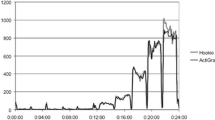Abstract
The objective of this feasibility study is to evaluate the use of the ‘Physilog’ device, an ambulatory physical-activity recorder based on acceleration measurement, for the monitoring of daily physical activities. Accelerations measured at the level of the chest and the thigh are recorded by Physilog over a period of 1 h in five normal subjects. A specially designed studio-like room allowing the performance of most usual activities of everyday life is used. A video film synchronised with the Physilog is obtained for each subject to check the accuracy of the data derived from Physilog. Based on the analysis of the average and the deviation of the acceleration signal, an algorithm is developed to classify the activities in four categories, i.e. lying, sitting, standing and locomotion. Compared with the video observations, the results from the algorithm show an overall misclassification of 10.7%, which is mainly due to confusion between dynamic activities and the standing posture. In contrast, the misclassification between postures is negligible. It is concluded that Physilog can be used in the clinical setting for the reliable measurement and long-term recording of most-usual physical activities.
Similar content being viewed by others
References
Aminian, K., Robert, Ph., Jéquier, E., andSchutz, Y. (1995a): ‘Estimation of speed and incline of walking using neural network’,IEEE Trans. Inst. Meas.,44, (3), pp. 743–746
Aminian, K., Robert, Ph., Jéquier, E., andSchutz, Y. (1995b): ‘Incline, speed and distance assessment during unconstrained walking’,Med. Sci. Sports Exec.,27, (2), pp. 226–234
Haskell, W. L., Yee, M. C., Evans, A., andIrby, P. J. (1993): ‘Simultanous measurement of heart rate and body motion to quantify physical activity’,Med. Sci. Sports Exerc.,25, pp. 109–115
Lieberman, J. R., Dorey, F., Shekelle, P., Schumaker, L., Thomas, B. J., Kilgus, D. J., andFinerman, G. A. (1996): ‘Differences between patients’ and physicians’ evaluations of outcome after total hip arthroplasty’,J. Bone Joint Surg.,78A, pp. 835–838
Makikawa, M., andIizumi, H. (1995): ‘Development of an ambulatory physical activity memory device and its application for categorization of actions in daily life’, Medinfo 95 Proceeding, pp. 747–750
Ng, A. V., andKent-Braun, J. A. (1997): ‘Quantitation of lower physical activity in persons with multiple sclerosis’,Med. Sci. Sports Exerc.,29, pp. 517–523
Patterson, S. M., Krantz, D. S., Montgomery, L. C., Deuster P. A., Hedges, S. M., andNebel, L. E. (1993): ‘Automated physical activity monitoring: validation and comparison with physiological and self- report measures’,Psychophysiology,30, pp. 296–305
Sieminski, D. J., Cowell, L. L., Montgomery, P. S., Pillai, S. B., andGardner, A. W. (1997): ‘Physical activity monitoring in patients with peripheral arterial occlusive disease’,J. Cardiopulmonary Rehabil.,17, pp. 43–47
Veltink, P. H., Bussmann, H. B. J., de Vries, W., Mertens, W. L. J., andVan Lummel, R. C. (1996): ‘Detection of static and dynamic activities using uniaxial accelerometers’,IEEE Trans. Rehabil. Eng.,4, pp. 375–385
Author information
Authors and Affiliations
Corresponding author
Rights and permissions
About this article
Cite this article
Aminian, K., Robert, P., Buchser, E.E. et al. Physical activity monitoring based on accelerometry: validation and comparison with video observation. Med. Biol. Eng. Comput. 37, 304–308 (1999). https://doi.org/10.1007/BF02513304
Received:
Accepted:
Issue Date:
DOI: https://doi.org/10.1007/BF02513304




